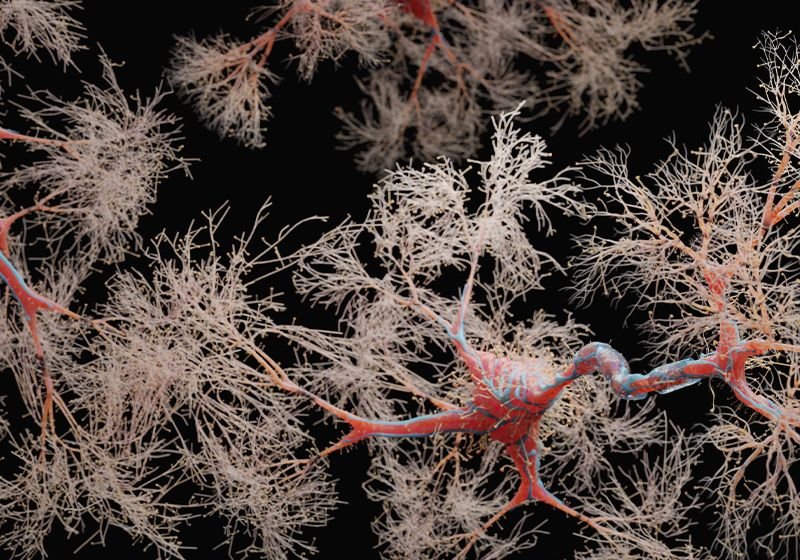Taste, like other senses, is mediated by finely tuned circuits of neurons. These circuits are formed during embryonic development, when many extra neuronal synapses that will not exist in the fully mature brain arise. The process of removing these extra connections, neuronal pruning, takes place in mice after birth through the activity of resident brain immune cells, microglia.1
David Hill, a sensory neurobiologist and emeritus professor at the University of Virginia, began studying the taste sensory circuit in the 1980s. “For every sensory system, and maybe every neural system, it’s important to know what the developmental processes are that lead to the adult system,” he said. His previous work demonstrated that limiting salt during the early embryonic period of rats and mice inhibited this neural pruning.2,3 In a recent study, Hill’s team showed that sodium restriction during gestation impaired microglia migration to a sensory hub in the brain and demonstrated a potential mechanism behind this sodium-sensitive neuronal pruning. These findings, published in the Journal of Experimental Medicine, help pinpoint how factors during gestation influence development of sensory circuits in offspring.4
Hill’s team fed pregnant mice a low-sodium diet between embryonic day 3 (E3) and E12, and then placed them back on a regular diet. They assessed differences in the densities of terminals in two nerves, which are important to the mouse taste circuit, from 15 to 60 days after birth (P15-P60). Neuronal pruning decreased the density of terminals between P20 and P30 in offsprings that were not subjected to sodium restriction in utero, while animals that experienced low-sodium diet in utero maintained high densities of neuron terminals. The researchers noted that these effects did not alter the taste circuit entirely, as a third nerve in the system was not affected by the diet.

Microglia (green) usually prune extra terminals from taste circuit nerves (blue and red) in mice, but exposure to a low-sodium diet during development impairs this process in mice.
Chengsan Sun and David Hill
Since microglia help prune excess neuron terminals, the team next investigated the density of these immune cells in this taste circuit at different points from embryonic to postnatal development between animals from low-sodium fed mothers and mice fed a normal diet. Developing embryos at E9.5 exposed to a low-sodium diet had significantly fewer microglia in their brains compared to embryos under a normal sodium diet. In adulthood, the regions of the brain that had less microglia migration corresponded to the taste circuits with reduced pruning.
The team then wanted to understand how low-salt exposure in utero affected terminal pruning in the mouse taste circuit. They turned to IL-34, an important cytokine for myeloid cell development produced by neurons, and IL-33, which promotes microglial synaptic pruning. They showed that mice exposed to a low-sodium diet exhibited less IL-34 at P22 compared to nonexposed mice, and that exposed mice also produced less IL-33 at P40. These results suggested that this low sodium diet may impair taste circuit synaptic pruning through altered neural-immune interactions.
Yali Zhang, a neuroscientist at the Monell Chemical Senses Center and University of Pennsylvania who was not involved in the study, said that the study’s findings on the influence of maternal gestational diet on offspring taste sensory development were interesting. He is particularly curious to see more detailed studies exploring how the low-salt diet influences microglial migration and potentially microglia development to yield the observed results. “That’s a big puzzle that needs to be solved in the future,” Zhang said.
References
- Schafer DP, et al. Microglia sculpt postnatal neural circuits in an activity and complement-dependent manner. Neuron. 2012;74(4):691-705
- Mangold JE, Hill DL. Postnatal reorganization of primary afferent terminal fields in the rat gustatory brainstem is determined by prenatal dietary history. J Comp Neurol. 2008;509:594-607
- Sun C, et al. Selective deletion of sodium salt taste during development leads to expanded terminal fields of gustatory nerves in the adult mouse nucleus of the solitary tract. J Neuro. 2017;37(3):660-672
- Sun C, et al. Maternal diet during early gestation influences postnatal taste activity-dependent pruning by microglia. J Exp Med. 2023;220(12):e20212476










